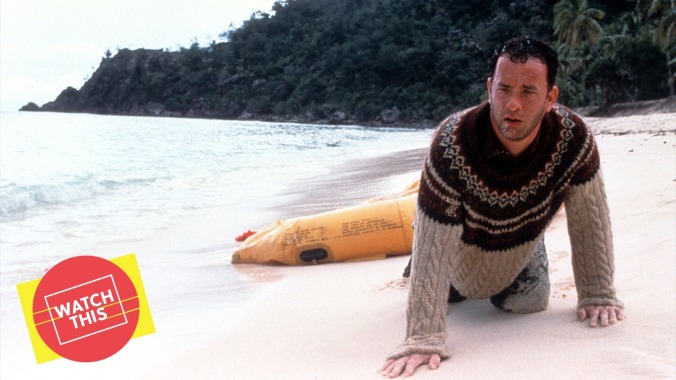Tom Hanks and Robert Zemeckis bid a fond farewell to the 20th century with Cast Away

Watch This offers movie recommendations inspired by new releases, premieres, current events, or occasionally just our own inscrutable whims. As part of Y2k week here at The A.V. Club, we’ll be listing the 25 best films of the year 2000. These are some of our favorites that didn’t make the countdown.
Cast Away (2000)
Director Robert Zemeckis had an eventful 2000, releasing the Hitchcockian thriller What Lies Beneath in the summer, followed by the more contemplative, comparably experimental Cast Away for the holidays. He actually began work on Cast Away first, shooting the first half of the movie following the travails of FedEx company man Chuck Noland (Tom Hanks), who lives for his on-the-go job until a plane crash leaves him stranded on an uncharted island somewhere in the Pacific. To accommodate the mid-movie four-years-later time jump, Zemeckis halted filming for six months so Hanks could lose weight and appear more realistically gaunt. He made What Lies Beneath during the break, then jumped back to finish off Cast Away.
It’s a notably old-fashioned technique, implemented with typical dedication by the technical wizard director. Cast Away deploys plenty of showy camera tricks, too, but Zemeckis uses them somewhat counterintuitively. Chuck’s frantic job, where workers “live or die by the clock,” is depicted largely in long, impressive tracking shots, rather than the fast cuts that most contemporary movies use to convey urgency. After the expertly nightmarish disorientation of the plane crash sequence, Zemeckis shoots Chuck’s island experiences with a more painterly calm, though he does cut in faster and closer when Chuck throws himself into the intense process of making fire. The island scenes have no musical score, and some have little dialogue. Though Hanks does famously chat with a blood-painted volleyball named Wilson, most of those conversations happen after the mid-movie time-jumping cut—a dissolve, actually, and a beautiful one, from fire to shimmering water.
In a way, Cast Away itself spends a lot of time dissolving between a survival procedural and a psychological drama. The latter pushes to the foreground in the movie’s second half, where Chuck decides to try sailing back to civilization. (20-year-old spoiler first made by the movie’s absurdly revealing trailers: He succeeds.) At the time of its release, Cast Away was dinged for serving as a feature-length commercial for FedEx, a description that ignores how Chuck’s dedication to his post results in personal catastrophe—and how, once Chuck makes it back to the world, his company essentially treats him as reclaimed property, showing him off in a hollow celebratory stupor. Though a musical score returns once Chuck hits the water, the post-island material is nonetheless even quieter and more reflective than what came before, with Hanks doing exceptional work as a man whose life slowed to a crawl for years, now figuring out the right speed for his forced reset.
Zemeckis had his own four-years-later moment after Cast Away became his biggest hit since Forrest Gump: He took one of his longest-ever directing breaks before re-emerging with the dead-eyed tech demo of The Polar Express, Hanks in tow. He would spend the next decade tinkering with 3D motion-capture productions that granted his camera complete freedom, with natural human relatability as the cost. These kinds of moves are foreshadowed by an early scene in Cast Away where the camera appears to be fixed to the side of a FedEx package, resulting in an extended mail’s-eye-view shot. In retrospect, Cast Away plays like a fond (albeit temporary) farewell to the world of live-action filmmaking, and all of its attendant limitations and potential; it’s an epic-length and technically sophisticated character study. The relentless drive for more work, more services, and more speed certainly hasn’t eased since the turn of the millennium (how many of us have used these exact services throughout the pandemic?), nor has the even-crueler passage of time. But studio demand for grown-up movies as thoughtful and well-made as Cast Away sure has.
Availability: Cast Away is currently streaming on HBO Max. It’s also available to rent or purchase from Amazon, Google Play, iTunes, YouTube, Microsoft, Fandango, Redbox, DirectTV, and VUDU.